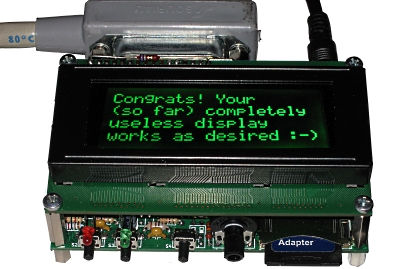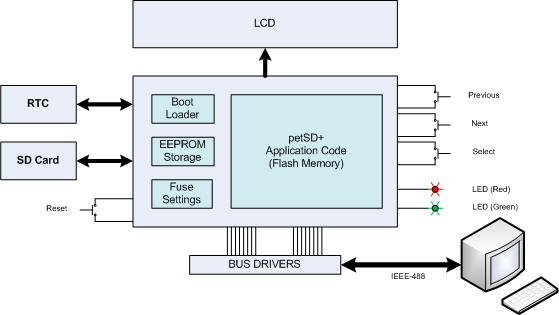|
 |
Commodore PET Projects
- petSD+ |
petSD+ - Software

Introduction
This page gives an overview of the functions available in
petSD+, these functions are executed from the microcontroller
flash memory, so should more correctly referred to as
Firmware. I have called this page "Software"
to differentiate it from the Firmware
programming
page.
petSD+ Overview
The diagram below shows a simplified block diagram of a fully
featured petSD+

For a more comprehensive description of the individual
components, see the hardware page.
For more details on Fuse Configuration
and the Boot Loader, see the
Firmware page.
petSD+ Application Code :
NODISKEMU
Nils has named the application (firmware) program running in petSD+
"NODISKEMU", at first glance, this
might seem to be an odd name for what appears to be a disk drive
emulator for the PET. In fact, NODISKEMU does not emulate any
particular vintage Commodore disk drives or their internals,
including their inbuilt CPUs, not does it run any version of
Commodore DOS.
It is just a storage solution that is capable of responding
to low level Commodore BASIC functions such as OPEN
or TALK and interprets commands sent
to channel 15 in a way similar to other drives. The deeper
meaning of this name is to clarify that there actually are, and
always will be, some differences to real floppy drives.
The NODISKEMU firmware is based on
sd2iec, created by Ingo Korb (et
al.), the most common use for this firmware is in the emulation of a
Commodore
1541 disk drive for the
Commodore 64
computer, but Nils has added support for the parallel IEEE-488
disk drives used with the PET/CBM range.
sd2iec is open source, released under the
GNU GPL license and is available from the
Git
repository here. Unfortunately,
there isn't a manual for sd2iec, although some information is
available from the
README file in the archive and some more "user friendly"
information has been posted to the
sd2iec page on the
C64 wiki.
Quoting from the wiki, some features relevant to the PET are
:
-
D64/D71/D80/D81/D82
image file support
- PRG/P00
etc. support
- Limited
REL
support
- Supports FAT long file names
- Supports FAT12/FAT16/FAT32 formatted SD and SDHC cards
- Supports most typical IEC functions (LOAD, SAVE, OPEN,
GET, PUT, CLOSE, ...)
- Real Time Clock (RTC) support
In normal operation, petSD+ is mainly concerned with passing
data between the host computer and the SD Memory card over the
IEEE-488 bus under the control of the application code in the
MCU Flash Memory. It is not necessary for the user to understand
the processes going on to support these activities, but some
awareness of the EEPROM storage area may be useful.
The EEPROM storage area has two uses in petSD+ :
- Preserving the state of user configurable options, such
as the IEEE-488 bus address
- Providing a small, non-volatile file area for user file
storage
Note: the Real Time Clock settings are
preserved by the RTC itself, provided that the CMOS battery is
present
User Settings
When the user elects to Save Settings
from any of the LCD control screens, the EEPROM is updated
with a new set of user configuration settings, it is not
possible to update a single parameter.
EEPROM File System
(From the NODISKEMU README)
*WARNING*: The
EEPROM file system is a newly-implemented file system that
may still contain bugs. Do not store data on it that you
cannot afford to lose. Always make sure that you have a
backup. Also, the format may change in later releases, so
please expect that the partition may need to be erased in
the future.
Devices running NODISKEMU always have
an EEPROM to store the system configuration, but on some
devices this EEPROM is much larger than required. To utilize
the empty space on these devices (currently any
microcontroller with at least 128K of flash), a special
EEPROM file system has been implemented. This can for
example be used to store a small file browser or fast loader
so it can be used independent of the storage medium that is
currently inserted.
The EEPROM file system does not
support subdirectories. It can be formatted using the N:
command as usual, but the disk name and ID are ignored. The
capacity of the EEPROM file system varies between devices:
On AVR devices, such as petSD+, it is 3.25 KBytes and at
most 8 files can be stored on it. The actual number of files
that can be stored depends on the length of the files,
longer files need more than one directory entry.
|